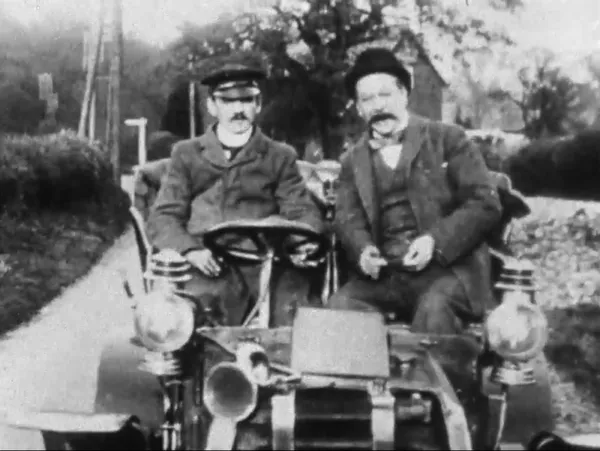 |
| Runaway Match |
Motion pictures and the motor car are almost the same age. Depending on how you tightly you define either of them, Louis Le Prince's Roundhay Garden Scene and Carl Benz' Patent Motor Car are from 1888 and 1886. Their shared history isn't just in parallel development, mass-market appeal, the drive-in, even the move to digital.
In 1903 Alf Collins had a car chase in Runaway Match (aka Marriage By Motor). It has features one would recognise even today, including shots from each of the vehicles to establish the boundaries of the chase. That the two vehicles are chauffeured is a consequence of its age, and the ending contains a surprise that - even after 120 years - is worth preserving.
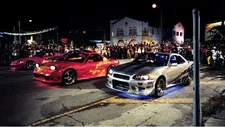 |
| The Fast And The Furious |
It's usually argued that 1968's Bullit is the first modern car-chase movie. The central chase features two iconic cars, the Dodge Charger and McQueen's steed, a Ford Mustang fastback. The roar of their engines masks that Lalo Schifrin's score isn't present from first corner to last explosion The chase itself serves two purposes, cementing Bullitt's icy cool and establishing just how ruthless The Outfit is. It sets stakes, defines characters, tells us something about those involved in the way that other scenes do. Other movies tell us as much about their protagonists and their circumstances as efficiently with driving too. The Driver's demolition of an orange Mercedes in Walter Hill's film, the Driver's trip to the basketball game in Nicolas Winding-Refn's Drive, even the overblown muscular straightforwardness of the drag race in the first of The Fast And The Furious.
Car chases are a staple of the action genre, and they are an almost obligatory component of spy films. While every Bond film has at least one, they often demonstrate the weaknesses of the franchise and are usually indicative of each outing's biggest flaws. The 'invisible' Jaguar of Die Another Day during Brosnan's tenure was a consequence of the impact of digital effects, and despite the fact that it used computer modelling before the entirely practical effect of the corkscrew jump in The Man With The Golden Gun was accompanied not only by 'comedy' Sheriff Pepper but a swanee whistle.
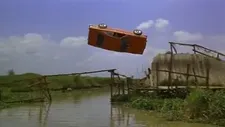 |
| The Man With The Golden Gun |
The Bourne franchise does its best to make its car chases credible tests of its superhuman protagonists' abilities, putting Matt Damon's Jason in a battered Mini, the Suzuki Samurai-a-like Maruti Gypsy King, a stolen Lada taxi, and not one but two stolen police cars, and giving Jeremy Renner's Aaron Cross a dirt-bike, with the twin passengers of Rachel Weisz and a genetically modifying virus. Ronin is widely regarded as another high point of spy car chases, though the central Marseilles encounter is effectively a rolling heist. The most important vehicle in it isn't the aluminium bodied Audi or the throaty BMW but the van with Stellan Skarsgard and his computer maps.
French film has a huge number of great car chases, mostly because of the local stunt teams. The Transporter and Taxi franchises are built on them, but films like Fast Convoy and Burn Out are also highlights. The French Connection was actually in New York, but Popeye Doyle's headlong pursuit of a train is a masterwork of guerrilla film-making, but 1976's C'Etait Une Rendezvous treats everything about that unauthorised driving as a challenge and surpasses it, including a tyre-squealing roar around the Arc-de-Triomphe. Other upgrades including using a Mercedes-Benz 450SEL 6.9 though it was over-dubbed with the sound of a Ferrari 275GTB, but both are streets ahead of a Pontiac LeMans.
All that established, however, the aim here is not to talk about car chases but car chaos.
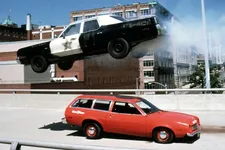 |
| The Blues Brothers |
The two are closely coupled. There's the alliterative, the Blues Brothers, Cop Car, and Mad Max (especially Fury Road) are all prime examples. The last two are effectively each one continuous chase, but the relentlessness of their action doesn't hide the carnage around it. A bullet goes in a straight line until it ricochets, and as with Bullitt sometimes that starts and ends with an explosion. That said, the climactic bang of the Blues Brothers in the Cook County assessor's office is that of Steven Spielberg's stamp, but we're not talking about stationery or the stationary but automotive aftermath.
There's the ones that make transport central, but as a vector for chaos. Under The Skin wouldn't usually feature on lists like this, but vehicles are vital. Less so than the source text, which featured a car fitted with drug rather than fuel-injection, and is now sufficiently old that the notion of fuelling a car for a fiver feels more alien than the film's focus on Scarlett Johansson's flattened affect or the relentless biker. Terminator 2 has one of those too, but the chaos there comes from things other than motor vehicles, though Arnie's Gatling gun and Robert Patrick's purloined helicopter do also have gearboxes.
Under The Skin isn't necessarily high-octane. The van bimbles down Glasgow's Parnie Street slowly enough to look in comic shop windows and is slowed to pedestrian pace in the Parkhead crowd. It is rich though, and that fuel is dark and absorbing. Car chaos isn't just about jumping buses over bridges like in Speed, but in the consequences.
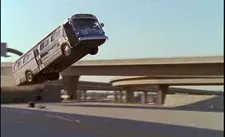 |
| Speed |
Blue Ruin is named in part for the car that is home and transport, and its collapse and degradation and partially successful restoration are all symptomatic and emblematic (if not systematic and hydromatic). Cop Car is named for the vehicle that puts lights and a siren on Aristotlean unity. 4x4 is a hostage drama that is close to a Phone Booth on wheels, though it's slightly more rounded. Similarly named, Scooter, albeit unpowered, motors its way to a fiendish conclusion on a charge of cheeseburger and chips. In general films named for a car will count, there's something about that centrality. That's true of Ambulance, of Armored, but by that rule Taxi Driver should rightly be called Pimp's Staircase.
In an era of cell-phone enabled electric transport, ride-sharing and private hire services have outings too. The Cabbie and A Taxi Of Coldness use the formalities of their circumstance to powerful effect, but Night Drive finds a new dimension to subvert expectations. Animated short Sierra might be closer to Rubber in that its got a protagonist that's a tyre (at least some of the time), but a lycanthropic Bibendum or predatory Pirelli is around our subject.
I had at one point considered trying to graph the chaos, but even staggering things by gear (or other ratios) it got a bit complicated. Chaotic, even. I ran out of dimensions long before I ran out of data. Trying to balance films that had few cars, travelling slowly, but lots of mayhem (Blue Ruin) and films that had loads of cars, hooning along, and plenty of larceny (Gone In 60 Seconds), and films that had two cars in a chase and a wedding (Runaway Match) and films that had two hundred cars in a chase and a concert (Blues Brothers) became hard. I've scarcely touched on The Fast & Furious franchise, where a nine-year old helped solve a different plotting problem with the words "magnet plane".
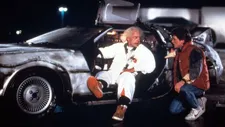 |
| Back To The Future |
Physics differently supports these stories. Doc Brown's Time Machine isn't as important to Back To The Future as the electric guitar, but it's close. Psychics would suggest Christine is aligned with the dark powers, and Spielberg's Duel depends on the the psychology of the sanctity and insecurity of the seat behind the wheel.
All these veins most richly bear fruit in Titane, which, while harder to represent in Scalextric, is my contention for the most chaotic car film. Given how many films from, Juno to Knocked-Up and back and beyond, are prompted by pregnancy, Titane puts a double-yellow line on the test. Plenty of car chases shot in first person can cause motion sickness, but Titane is one of the few films where a screening I've attended has seen an ambulance called. It's not alone in having fire engines and stripping. Ballard's Crash and much of Cronenberg draws from the same mixture of suck, squeeze, bang, and blow.
Cinematic chaos draws much from the motorcar, and so it seems fair to conclude by talking about the reverse. Fictional vehicles have tributes in real life, from slot-car scale models, the die-cast fleet that sits around my TV and on my DVD shelves, and the full scale driving replicas. There's a whole litany of litigation around the Shelby Mustang 'Eleanor', a legal battle around the boundaries of copyright from the star vehicle of the Nicolas Cage/Angelina Jolie/Vinne Jones star vehicle Gone In 60 Seconds has perhaps finally been resolved after 18 years of wrangling. Many modern cars have media centres, but few beat the BMW 7 series G70. It has an 8K ultrawide screen that folds down for the rear passengers, allowing you to watch almost anything as Christopher Nolan intended while being driven to school. It's that last that is the closest I've come to causing cinematic car chaos myself. Finding oneself stuck behind a family pacifying their children with tablets hanging from their parents' seatbacks is one thing, but trying to figure out what they are watching means that one can very quickly come in contact with their bumper, doing an impression of a trailer.





















